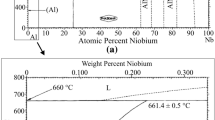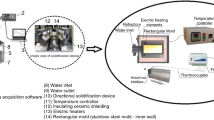Abstract
The possibility of changing the dendritic microstructure associated with the conventional casting processes of hypoeutectic Al-Si alloys to non-dendritic microstructure by using the controlled diffusion solidification process (CDS) has been investigated. The successful CDS process depends on mixing two precursor alloys heated at a superheat condition near their respective liquidus temperature. Experimental work and simulation work using Ansys software were carried out in the present study by employing Al-Si and Al-Cu systems. This study investigates the effect of the content of the two precursor alloys, the mass ratio changing from 2.6 to 8.3, and the superheat of the first precursor alloy on changing the microstructure. The experimental results show that the pure aluminum used as the first precursor alloy needs more undercooling and agitation during the mixing to form the non-dendritic microstructure compared with hypoeutectic Al-Si alloys. Furthermore, mixing pure aluminum with hypereutectic alloy can change the microstructure of hypoeutectic alloys leading to extending the possibility to choose the second precursor alloy. The results also show that a higher mass ratio is preferred when mixing pure aluminum with hypoeutectic alloy. Furthermore, the microstructure of the alloy Al- 6.45Si- 4Cu- 0.5 Mg- 0.66Fe- 0.66 wt%Zn was successfully changed via the CDS process by mixing Al- 7.75Si- 0.79Fe- 0.78Zn- 0.6 wt%Mg at 2 °C superheat into Al-24 wt%Cu at around 5 °C superheat. The simulation results show that lower air bubbles and better distribution of the two precursor alloys happen during the mixing step when using the Al-Cu system.








Similar content being viewed by others
Availability of data and materials
The experimental and simulation data is transparent.
Notes
Ansys 15, Ansys Inc.
Thermo-Calc academic 2020.
Abbreviations
- Alloy1 :
-
First precursor alloy
- Alloy2 :
-
Second precursor alloy
- Alloy3 :
-
Resultant alloy
- AL and BL :
-
Variables of density
- C 1 :
-
Composition of Alloy1 (wt%)
- C 2 :
-
Composition of Alloy2 (wt%)
- C Al :
-
Aluminum concentration (wt%)
- C Cu :
-
Copper concentration (wt%)
- C o :
-
Composition of Alloy3 (wt%)
- C P :
-
Specific heat (Jkg−1 K−1)
- C Si :
-
Silicon concentration (wt%)
- C Solute :
-
Solute concentration (wt%)
- Hsol :
-
Heat of solution (J)
- m1 :
-
Mass of Alloy1 (kg)
- m2 :
-
Mass of Alloy2 (kg)
- mr :
-
Mass ratio (m1/m2)
- N :
-
Number of species
- T :
-
Temperature (K)
- T 1 :
-
Alloy1 temperature (K)
- T 2 :
-
Alloy2 temperature (K)
- T L :
-
Liquidus temperature (K)
- T S :
-
Solidus temperature (K)
- T L1 :
-
Liquidus temperature of Alloy1 (K)
- T L2 :
-
Liquidus temperature of Alloy2 (K)
- T∞ :
-
Bulk temperature (K)
- U :
-
Velocity (ms−1)
- β T :
-
Temperature dependence variable
- β C :
-
Concentration dependence variable
- µ :
-
Viscosity (mPa)
- Ω:
-
Regular solution
- K :
-
Thermal conductivity (WK−1m−2)
- 𝛔 :
-
Surface tension (Nm−1)
- ρ :
-
Density (kgm−3)
- η Alloy :
-
Multy component viscosity (mPa)
References
Ye H (2003) An overview of the development of Al-Si-alloy based material for engine applications. J Mater Eng Perform 12:288–297. https://doi.org/10.1361/105994903770343132
Ahn SS, Pathan S, Koo JM et al (2018) Enhancement of the mechanical properties in Al-Si-Cu-Fe-Mg alloys with various processing parameters. Materials (Basel) 11. https://doi.org/10.3390/ma11112150
Timpel M, Wanderka N, Schlesiger R et al (2012) The role of strontium in modifying aluminium-silicon alloys. Acta Mater 60:3920–3928. https://doi.org/10.1016/j.actamat.2012.03.031
Mirzadeh H, Niroumand B (2009) Fluidity of Al-Si semisolid slurries during rheocasting by a novel process. J Mater Process Technol 209:4977–4982. https://doi.org/10.1016/j.jmatprotec.2009.01.020
Saha D, Shankar S, Apelian D, Makhlouf MM (2004) Casting of aluminum-based wrought alloys using controlled diffusion solidification. Metall Mater Trans A 35:2174–2180. https://doi.org/10.1007/s11661-004-0167-8
Khalaf AA, Ashtari P, Shankar S (2009) Controlled diffusion solidification (CDS): conditions for non-dendritic primary aluminum phase in Al-Cu Hypo-eutectic alloys. In: The Third International Symposium, TMS (The Minerals, Metals & Materials Society). pp 215–222
Saha D, Shankar S, Apelian D, Makhlouf MM (2005) Controlled diffusion solidification-manufacturing net shaped al-based wrought alloy parts. In: Proceedings of the John Campbell Honorary Symposium Edited by P. Crepeau and M. Tiryakioglu TMS (The Minerals, Metals & Materials Society)
Ashtari P, Birsan G, Khalaf A et al (2011) Controlled diffusion solidification of 2024,6082 and 7075 Al alloys via tilt-pour casting process. Int J Met 5:43–63
Ghiaasiaan R, Zeng X, Shankar S (2014) Controlled diffusion solidification (CDS) of Al-Zn-Mg-Cu (7050): microstructure, heat treatment and mechanical properties. Mater Sci Eng A 594:260–277
Khalaf AA, Shankar S (2011) Favorable environment for a nondendritic morphology in controlled diffusion solidification. Metall Mater Trans A 42:2456–2465
Khalaf AA (2010) Controlled diffusion solidification: process mechanism and parameter study. Ph.D Thesis. McMaster University
Khalaf AA, Shankar S (2020) Mechanism of anomalous grain formation during controlled diffusion solidification. JOM. https://doi.org/10.1007/s11837-020-04198-1
Khalaf AA, Shankar S (2012) Effect of mixing rate on the morphology of primary Al phase in the controlled diffusion solidification (CDS) process. J Mater Sci 47:8153–8166
Khalaf AA, Ashtari P, Shankar S (2009) Formation of nondendritic primary aluminum phase in hypoeutectic alloys in controlled diffusion solidification (CDS): a hypothesis. Metall Mater Trans B 40:843–849
Khalaf AA (2016) Mechanism of controlled diffusion solidification: mixing, nucleation and growth. Acta Mater 103:301–310
Khalaf AA, Takrouri KJ (2020) Spontaneous nucleation in hypoeutectic Al – Cu system by controlled diffusion solidification process. SN Appl Sci 2:1337
Khalaf AA (2021) Studying of non-dendritic microstructure forming in controlled diffusion solidification. Int J Met. https://doi.org/10.1007/s40962-021-00590-y
Ghiaasiaan R, Shankar S (2020) Microstructure, intermetallic phases, and fractography of the cast Al-5.8Zn-2.2Mg-2.5Cu alloy by controlled diffusion solidification. Metall Mater Trans A Phys Metall Mater Sci 51:4711–4726. https://doi.org/10.1007/s11661-020-05885-z
Ghiaasiaan SR, Khalaf AA, Zheng X, Shankar S (2012) Near net shaped casting of 7050 Al wrought alloy by CDS process: microstructure and mechanical properties. Light Metals 2012:313–318
Ghiaasiaan SR, Shankar S, Apelian D (2014) Control diffusion solidification (CDS): an overview of mechanism and application. Shape Cast 5th Int Symp pp. 89–97. https://doi.org/10.1002/9781118888100.ch11
Ghiaasiaan SR, Khalaf AA, Zheng X, Shankar S (2012) Near net shaped casting of 7050 Al wrought alloy by CDS process : microstructure and mechanical properties. In: TMS (The Minerals, Metals & Materials Society). pp. 313–318
Ghiaasiaan SR (2015) Controlled diffusion solidification process (CDS) of Al-7XXX wrought alloys: heat treatment, microstructure, and mechanical properties. McMaster University
Yang X, Li YD, Luo XM et al (2019) Microstructural evaluation and mechanical properties of 7075 aluminum alloy prepared by controlled diffusion solidification. China Foundry 16:238–247. https://doi.org/10.1007/s41230-019-9059-9
Pourgharibshahi M, Divandari M, Saghafian Larijani H, Ashtari P (2017) Controlled diffusion solidification processing: a review. J Mater Process Technol 250:203–219. https://doi.org/10.1016/j.jmatprotec.2017.07.018
Symeonidis K (2009) The controlled diffusion solidification process: fundamentals and principles.Ph.D Thesis. Worcester Polytechnic Institute (WPI)
Apelian D, Makhlouf MM, Saha D (2006) CDS Method for casting aluminium-based wrought alloy compositions: theoretical framework. In: Materials Science Forum. pp. 1771–1776
Ashtari P, Birsan G, Khalaf A, Shankar S (2011) Controlled diffusion solidification of 2024,6082 and 7075 Al alloys via tilt-pour casting process. Int J Met 43–63
Wu M, Ludwig A (2009) Modeling equiaxed solidification with melt convection and grain sedimentation-II. Model verification Acta Mater 57:5632–5644. https://doi.org/10.1016/j.actamat.2009.07.067
Valencia JJ, Quested PN (2008) ASM Handbook Committee/Thermophysical Properties
Kurz W, Fisher DJ (1984) Fundamentals of solidification, 2nd edn. Trans Tech Publications, Aedermannsdorf
Dogan A, Arslan H (2018) Thermophysical properties of Cu–In–Sn liquid Pb-free alloys: viscosity and surface tension. Philos Mag 98:37–53. https://doi.org/10.1080/14786435.2017.1392053
Zhang F, Du Y, Liu S, Jie W (2015) Modeling of the viscosity in the AL-Cu-Mg-Si system: database construction. Calphad Comput Coupling Phase Diagrams Thermochem 49:79–86. https://doi.org/10.1016/j.calphad.2015.04.001
Yoshikawa T, Morita K (2006) Activity measurements of Al and Cu in Si – Al – Cu melt at 1273 and 1373 K by the equilibration with molten Pb. J Alloys Compd 420:136–144. https://doi.org/10.1016/j.jallcom.2005.10.071
Miettinen J, Visuri VV, Fabritius T (2019) Thermodynamic description of the Fe-Al-Mn-Si-C system for modelling solidification of steels. Acta Universitatis Ouluensis C Technica pp. 704:242
Wang F, Liu ZL, Qiu D et al (2015) The influence of the effect of solute on the thermodynamic driving force on grain refinement of Al alloys. Metall Mater Trans A Phys Metall Mater Sci 46:505–515. https://doi.org/10.1007/s11661-014-2599-0
Schmitz J, Brillo J, Egry I, Schmid-Fetzer R (2009) Surface tension of liquid Al-Cu binary alloys. Int J Mater Res 100:1529–1535. https://doi.org/10.3139/146.110221
Kobatake H, Brillo J, Schmitz J, Pichon PY (2015) Surface tension of binary Al–Si liquid alloys. J Mater Sci 50:3351–3360
Khalaf AA (2022) Metastable transition temperature in undercooled hypereutectic Al-Si alloys. Scr Mater 210
Acknowledgements
The authors are grateful to Mr. Doug Culley, Mr. Xiaogang Li, and Xiaochun Zheng for assisting in this research project.
Author information
Authors and Affiliations
Contributions
AAK designed the study, performed the research, analyzed the data, wrote the paper, and conducted experiments and data processing.
Corresponding author
Ethics declarations
Ethics approval
This article does not contain any studies with human participants performed by any of the authors.
Consent to participate
This work was conducted with no human test subjects.
Consent for publication
This work has consent for publication.
Conflict of interest
The authors declare no competing interests.
Additional information
Publisher's Note
Springer Nature remains neutral with regard to jurisdictional claims in published maps and institutional affiliations.
Rights and permissions
About this article
Cite this article
Khalaf, A.A. Microstructure evolution of Al-Si hypoeutectic alloys prepared by controlled diffusion solidification. Int J Adv Manuf Technol 120, 5003–5014 (2022). https://doi.org/10.1007/s00170-022-09075-6
Received:
Accepted:
Published:
Issue Date:
DOI: https://doi.org/10.1007/s00170-022-09075-6





